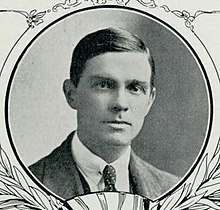George English (tenor)
George Philip John Engisch[1] (1882[2]–1972[2]), later English, was an Australian tenor soloist,[3] composer[1] and conductor.[1] His two symphonies of the early 1930s (No. 1 of 1932 and No. 2 of 1933) represent the late-Romantic style just like the better-known late symphonies by Alfred Hill.[2]

English was born in Sydney[3][4] but later resided in Melbourne.[4] He moved to Brisbane in the 1940s and established the Brisbane Opera Guild.[2]
He sang in J.S. Bach's St Matthew Passion and Christmas oratorios.[3] In the late 1910s he sung the tenor parts in Hector Berlioz's La damnation de Faust with the Sydney Philharmonic.[3] By 1920 he was tenor soloist at St. Paul's Cathedral in Melbourne.[3]
In May 1920 he participated in the Beethoven Festival organized by the New South Wales Conservatorium being the soloist in Beethoven's Missa solemnis (on 15 May).[3]
He married Marjorie Blanche, née Hodgson.[1] They had a son, George Selwyn English, who also became a composer. The pair divorced in 1929, which resulted in financial difficulties.[1][5]
In 1935 the University of Melbourne decided to establish a Bach Society under the direction of Professor Bernard Heinze and the conductorship of George English.[6]
[5] On 10 May 1939 he was before the bankruptcy court in Melbourne. In June he was transferred by the ABC to Sydney.[5]
In 1942 he was appointed conductor of the Queensland State and Municipal Choir (in succession to E.R.B. Jordan).[4] The first rehearsal took place at the beginning of August.[4]
George English was Conductor of the Heidelberg District Musical Society from 1924 to 1926.[7] He also conducted the Victorian Postal Institute Choir.
Compositions
Both Symphony No. 1 and Symphony No. 2 by George English were performed by the Melbourne Symphony Orchestra under his direction at the Melbourne Centenary Celebrations[4] (1934).[2] His oratorio Armageddon was performed on 9 November 1941.[8][2] In 1947 he composed a String Quartet, which got its first public performance on 30 October 1950 in Brisbane Albert Hall by the Queensland State String Quartet.[9] He also composed several songs.[3]
- The Six-starred flag of Anzac for 2 voices and piano (1919)[5]
- Symphony No. 1 in A major, Op. 4[2] (1932)[2]
- Symphony No. 2 in D minor, Op. 5[2] (1933)[5]
- Armageddon, oratorio for SATB, mixed choir and orchestra (1941)[5]
- String Quartet in F major (1947, premiered 1950)[10]
- Six negro spirituals arranged as part songs (SATB)[11]
Sources
- Rhoderick McNeill (23 March 2016). The Australian Symphony from Federation to 1960. Routledge. pp. 72–74. ISBN 978-1-317-04087-3.
References
- John Carmody. English, George Selwyn (1912–1980) / Australian Dictionary of Biography, National Centre of Biography, Australian National University, published first in hardcopy 1996
- Rhoderick McNeill (23 March 2016). The Australian Symphony from Federation to 1960. Routledge. pp. 72–74. ISBN 978-1-317-04087-3.
- Souvenir program of Beethoven Festival 1920
- An article in Brisbane The Telegraph, 4 Aug 1942
- Stephen Pleskun (17 January 2012). A CHRONOLOGICAL HISTORY OF AUSTRALIAN COMPOSERS AND THEIR COMPOSITIONS: (VOLUME 1: 1901–1954). Xlibris Corporation. ISBN 978-1-4653-8226-9.
- An article in the Melbourne Advocate, 8 Aug 1935
- Heidelberg News, 9-Feb-1924
- Stephen Pleskun (17 January 2012). A CHRONOLOGICAL HISTORY OF AUSTRALIAN COMPOSERS AND THEIR COMPOSITIONS: (VOLUME 1: 1901–1954). Xlibris Corporation. p. 601. ISBN 978-1-4653-8226-9.
- A review of the concert by Ernest Briggs in The Courier-Mail, 31 Oct 1950.
- Catalogue entry at the University of Melbourne.
- Catalogue entry at the National Library of Australia.